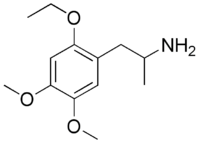EMM (psychedelic)
Appearance
This article relies largely or entirely on a single source. (July 2019) |

| |
| Names | |
|---|---|
| Preferred IUPAC name
1-(2,4,5-Trimethoxyphenyl)propan-2-amine | |
| Identifiers | |
3D model (JSmol)
|
|
| ChemSpider | |
PubChem CID
|
|
| UNII | |
CompTox Dashboard (EPA)
|
|
| |
| |
| Properties | |
| C13H21NO3 | |
| Molar mass | 239.315 g·mol−1 |
Except where otherwise noted, data are given for materials in their standard state (at 25 °C [77 °F], 100 kPa).
| |
EMM (2-ethoxy-4,5-dimethoxyamphetamine) is a lesser-known substituted amphetamine. It is a dimethoxy-ethoxy analog of trimethoxyamphetamine (TMA-2). EMM was first synthesized by Alexander Shulgin. In his book PiHKAL, both the dosage and duration are unknown.[1] EMM produces few to no effects. Very little data exists about the pharmacological properties, metabolism, and toxicity of EMM.
See also
[edit]References
[edit]
